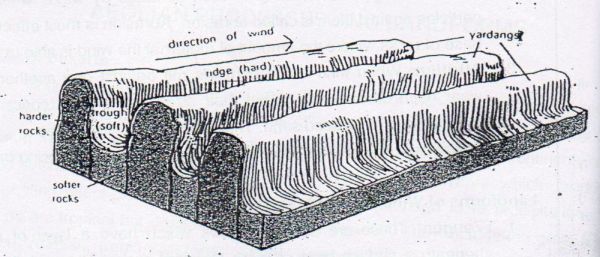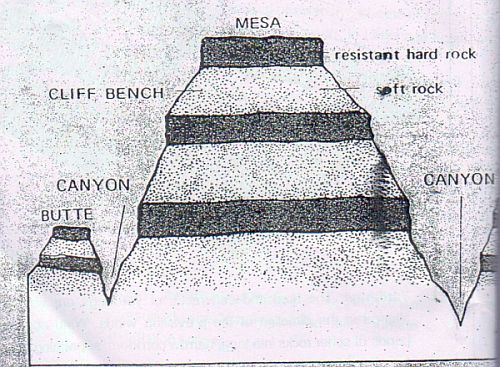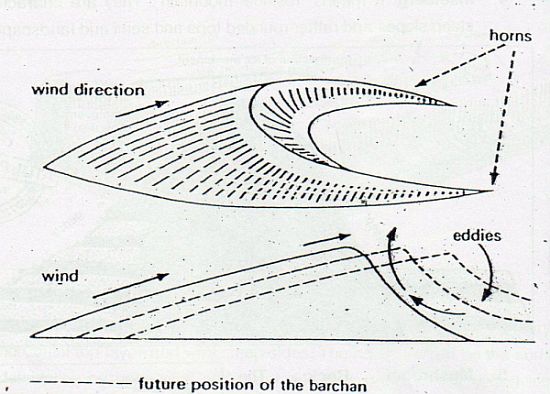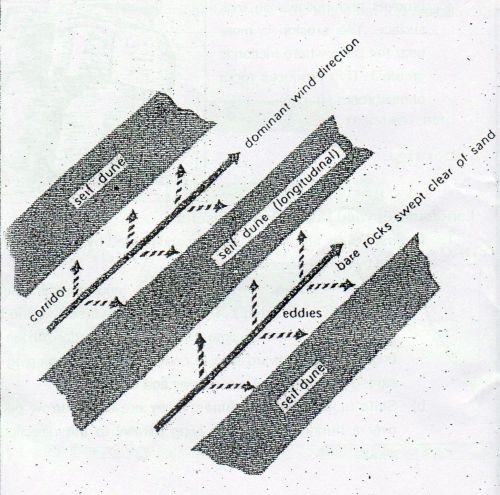(World Geography) Aeolian Processes & Landforms - Mechanism of Arid, Wind Erosion & Deposition in Deserts
WORLD GEOGRAPHY
Concepts of Geography, Natural Resources
AEOLIAN PROCESSES AND LANDFORMS
Types of Deserts: There is a certain definite pattern to the location of the world’s deserts. Almost all the deserts are confined within the 15o to 30o parallels of latitude north and south of the equator. They lie the trade wind belt on the western parts of the continents where Trade winds are off-shore. They are bathed by cold currents which product a ‘desiccating affect’ so that moisture is not easily condensed in to precipitation. Such deserts are tropical hot deserts or ‘Trade Wind deserts’. They include the grate Sahara Desert; Arabian, Iranian and Thar desert; Kalahari, Namib, and Atacama Deserts the great Australian deserts and the deserts of south-west U.S.A. in the continental interiors of the mid latitudes, the deserts such as the Gobi and Turkestan are characterized by extremes of temperatures. There are distinct landscapes in a desert.
1. Hamada or rocky deserts: This consists of large stretches of bare rocks, swept clear of sand and dust by the wind. The exposed rocks are thoroughly smoothed and polished. The region is bare and sterile. The best known rocky deserts are those of the Sahara Deserts e.g. the Hamada, in Libya, which covers an area of almost 20,000 square miles.
2. Reg or stony deserts: This is composed of extensive sheets of angular pebbles and gravels which the winds are not able to blow off. In Libya and Egypt the term serir is used; elsewhere in Africa, stony desert are called reg.
3. Erg or sandy desert: This is a sea of sand in which winds deposit vast stretches of undulating sand-dunes in the heart of the desert. The intricate patterns of ripples on the dune surfaces indicate the directions of the winds.
4. Mountain deserts: Some deserts are found on highlands such as plateaux and mountains ranges. Erosion has dissected the desert highlands into harsh, serrated outlines of chaotic peaks and craggy ranges. Their steep slopes are cut by winds and the action of frost has carved out sharp, irregular edges. Tibesti Mountains are good examples of desert mountains.
The Mechanism of Arid Erosion
1. Deflation: This involves the lifting and blowing away of loose materials from the ground. Deflation results in the lowering of the land surface to form large depressions called deflation hollows.
2. Abrasion: The sand-blasting of rock surfaces by winds when they hurl sand particles against them is called abrasion. Abrasion is most effective at or near the base of rocks, where the amount of maternal the wind is able to carry is greatest.
3. Attrition: When wind borne particles roll against one another in collision they wear each other away so that their sizes are greatly reduced and grains are rounded into millet seed sand. This process is called attrition.
4. Saltation: Slightly larger particles move by rolling or bouncing on the ground.
Landforms of Wind Erosion in Deserts
1. Zeugen: There are tabular masses which have a layer of soft rocks laying beneath a surface layer of more resistant rocks. The sculpting effects of wind abrasion wear them into a weird-looking ‘ridge and furrow’ landscape. Mechanical weathering initiates their formation by opening up joints of the surface rocks. Wind abrasion further ‘eats’ into the underlying softer layer so that deep furrows are developed.

2. Yardangs: The hard and soft rocks of yardangs are vertical bends and are aligned in the direction of the prevailing winds. Wind abrasion excavates the bends of softer rocks into long, narrow corridors, separating the steep-sides over-hanging ridges of hard rocks, called yardangs.
3. Mesas and buttes: It is a flat, table like land mass with a very resistant horizontal top layer and very steep sides. The hard stratum on the surface resists denudation by both wind and water and thus protects the underlying layers of rocks from being eroded away. Continued denudation through the ages may reduce mesas in area so that they become isolated flat-topped hills called buttes.

4. Inselberg: It means “residual mountain”. They are characterized by their very steep slopes and rather rounded topes and semi arid landscapes in old age.
5. Mushroom Rock: The sandblasting effect cuts grooves and hollows on rock surface. The erosion is more near the base where friction is greatest. This produces rocks of mushroom shape.
Landforms of Wind Deposition in Deserts
1. Dunes : Dunes are in fact, hills of sand formed by the accumulation of sand and shaped by the movements of winds.
a) Barchan - These are crescentic or moon-shaped dunes which occur individually or in groups. They occur transversely to the wind, so that their horns thin out and become lower in the direction of the winds around the edges. The windward side is convex and gently-sloping while the leeward side. Being sheltered is concaves and steep.
b) Seifs or longitudinal dunes - They are long narrow edges of sand, often over a hundred miles long lying parallel to the direction of the prevailing winds.


2. Loess: Fine dust blown beyond the desert limits is deposited on neighbouring lands as loess.
Landforms due to water action in deserts: Sometimes water collected in a depression or a desert basin doses not completely disappear by evaporation or sea page and a temporary lake is formed. Such lakes contain a high percentage of salts, because of high evaporation, and are glistening white when they dry up called playas. The bajda is a depositional feature made up of alluvial material laid down by the intermittent streams. The pediment is an erosional plain formed at the base of the surrounding mountain scraps.
data-matched-content-ui-type="image_card_stacked"
Useful Tips & Articles
तैयारी कैसे करें? |
EXAM SUBJECTS |
STUDY RESOURCESDownload Free eBooks |


